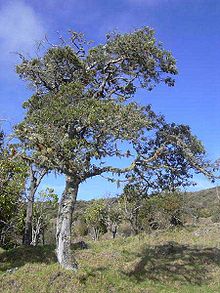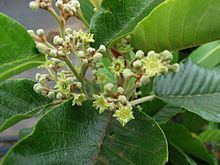| Alphitonia ponderosa | |
|---|---|

| |

| |
| Alphitonia ponderosa flower | |
| Conservation status | |
 Vulnerable (IUCN 3.1) | |
| Scientific classification | |
| Kingdom: | Plantae |
| Clade: | Tracheophytes |
| Clade: | Angiosperms |
| Clade: | Eudicots |
| Clade: | Rosids |
| Order: | Rosales |
| Family: | Rhamnaceae |
| Genus: | Alphitonia |
| Species: | A. ponderosa |
| Binomial name | |
| Alphitonia ponderosa Hillebr. | |
Alphitonia ponderosa is a species of flowering tree in the family Rhamnaceae, that is endemic to the Hawaiian Islands. It is locally known as kauila, as is the related Colubrina oppositifolia.
Description
Alphitonia ponderosa is a medium to large tree, reaching 15–24 m (49–79 ft) high with a trunk 20–60 cm (7.9–23.6 in) in diameter.
Leaves
The alternate leaves are ovate, 5–15 cm (2.0–5.9 in) long, and have 13–25-millimetre (0.51–0.98 in) petioles. The leaves are shiny, hairless, and green on the top, but are a dull light green with rust-colored veins on the bottom.
Flowers
Flowers of A. ponderosa are polygamous and form cymes at the bases of leaves. They are 6 mm (0.24 in) in diameter; the five sepals are 1.5 mm (0.059 in) and cover five 0.75-millimetre (0.030 in) petals.
Fruit
The fruit of A. ponderosa is a 15-millimetre (0.59 in) diameter drupe, which contain two to three seeds. The seeds are shiny, oblong, and have a red covering.
Habitat
Alphitonia ponderosa inhabits dry, coastal mesic, and mixed mesic forests at elevations of 240–1,250 m (790–4,100 ft) on all main islands, but is rare except on Kauaʻi. It grows as a shrub on exposed ridges.
Uses
The reddish-brown wood of A. ponderosa is highly prized for its beauty, strength, and density. It was used as a replacement for metal by the Native Hawaiians, who made laʻau melomelo (fishing lures), pāhoa (daggers), ihe (short spears), pololū (long spears), ʻōʻō (digging sticks), hohoa (round kapa, beaters) ʻiʻe kūkū (square kapa beaters), leiomano (shark tooth clubs), and kiʻi (tiki carvings) with it.
Conservation
Alphitonia ponderosa is considered a vulnerable species by the IUCN because of its fragmented distribution and declining population. Major threats include rats, pigs, deer, competition with introduced species of plants, and wildfire.
See also
References
- Bruegmann, M.M.; Caraway, V. (2003). "Alphitonia ponderosa". IUCN Red List of Threatened Species. 2003: e.T44076A10848537. doi:10.2305/IUCN.UK.2003.RLTS.T44076A10848537.en. Retrieved 14 November 2021.
- ^ Little Jr., Elbert L.; Skolmen, R.G. (1989). "Kauila" (PDF). United States Forest Service.
{{cite journal}}: Cite journal requires|journal=(help) - "kauila, kauwila, oa (Maui)". Hawaiian Ethnobotany Online Database. Bernice P. Bishop Museum. Retrieved 2009-03-25.
- Medeiros, A. C.; C.F. Davenport; C.G. Chimera (1998). "Auwahi: Ethnobotany of a Hawaiian Dryland Forest" (PDF). Cooperative National Park Resources Studies Unit, University of Hawaiʻi at Mānoa.
{{cite journal}}: Cite journal requires|journal=(help) - Bruegmann, M.M. & Caraway, V. (2003). "Alphitonia ponderosa". IUCN Red List of Threatened Species. 2003: e.T44076A10848537. doi:10.2305/IUCN.UK.2003.RLTS.T44076A10848537.en.
This Rhamnaceae article is a stub. You can help Misplaced Pages by expanding it. |
This rosid tree article is a stub. You can help Misplaced Pages by expanding it. |